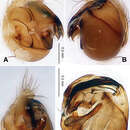en
names in breadcrumbs


The spider family Theridiosomatidae (ray orbweavers) includes 101 described species (Platnick 2014). The family has a worldwide, but mainly tropical, distribution. Two species, Theridiosoma gemmosum and T. savannum, are known from North America north of Mexico, where they are distinctive in being very small spiders with extremely stout first femora, abundant macrosetae ("spines"), chelicerae with robust teeth, and very large male genitalia. Both North American species are known only from eastern North America. Theridiosoma gemmosum is found across most of the eastern United States and southern Ontario (Canada) and is also widely distributed in northern Europe, where it may be introduced. Theridiosoma savannum has a more southern distribution and is only common along the Gulf Coastal Plain. Although the two species are broadly sympatric (i.e., their geographic ranges overlap), they prefer different microhabitats. Theridiosoma gemmosum prefers extremely humid microhabitats that are almost always in closed canopy forests whereas Theridiosoma savannum spins horizontal orb webs on the surface of coarse (i.e., broadleaf) leaf litter in moist, closed-canopy southeastern forests, e.g. of live oaks and gum trees. In the field, these spiders spin modified but recognizable orbwebs with radii that join before reaching the hub and a "tension" line extending from the hub to the substrate with which the spider distorts the web into a cone when ready to capture prey. Coddington (2005) provides details on web placement, web construction, and prey capture for both North American species. Both North American species are unusual among orbweavers in being primarily diurnal predators (Coddington 2005). Coddington notes that both of these species make papery brown egg sacs suspended from a silk line, forked at the top, and that these egg sacs are often the most conspicuous indication that theridiosomatids are present. Coddington (2005) reviews the taxonomic history of this family.
(Coddington 2005)